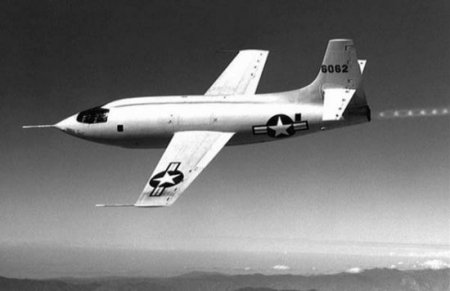X-1

Bell Aircraft Corporation X-1-1 in flight. The shock wave pattern in the exhaust plume is visible. Credit: NASA Dryden Flight Research Center.
The X-1 was the first of the X-planes. It was based on the shape of a .22 caliber bullet, with revolutionary thin, straight wings. The rocket-powered Bell X-1 was carried to a height of about 12,200 meters under the belly of a Boeing B-29 Superfortress before being released. Its prime mission was to break the sound barrier, a feat accomplished for the first time on 14 October 1947, when Charles "Chuck" Yeager accelerated his X-1 (christened by him "Glamorous Glennis", after his wife) to Mach 1.06 (1,130 kilometers per hour).
One of the problems associated with the supersonic X-1 research project was the matter of connecting the diminutive rocket plane to the launching bay of its B-29 mother ship. Even with its bomb bay doors removed, the converted B-29 sat too close to the ground to clear its passenger. However, a simple solution proved to work very well. Early in 1946, Muroc Air Force Base engineers constructed a small, cruciform pit near the edge of the flight line which just fit the X-1. It was then an easy matter to roll the small rocket plane into the pit, tow the B-29 over it, and then hoist it up into the bay. Once secured by a bomb shackle, the X-1's water-alcohol and liquid-oxygen tanks were topped off.
The X-1 program was the Air Force's first foray into experimental flight research and its first collaborative effort with NACA (National Advisory Committee on Aeronautics). Bell Aircraft built three of the original X-1s, plus an X-1A, X-1B, and X-1D. There was also an X-1E rebuilt from the X-1 #2. They flew a total of 214 flights between 1946–1958; the three original X-1s completed 157 flights between January 1946 and October 1951.
| X-1 data | |
|---|---|
| length | 9.4 m |
| wingspan | 8.5 m |
| mass, fully fuelled | 5,560 kg |
| thrust | 26,700 N |
| maximum speed | 1,540 km/h (Mach 1.45) |
| maximum altitude | 21,916 m |

